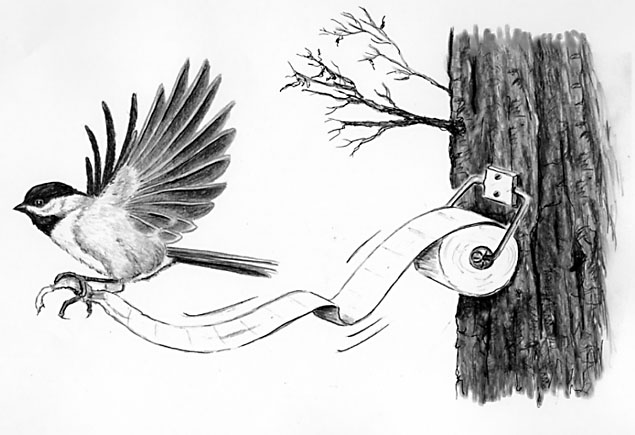
Dear Bird Folks,
I came out to my car this morning and found clear liquid in the middle of my windshield. It was about an inch wide and three inches long. It didn’t look like water to me, plus the sun was out. I don’t mean to sound gross, but do birds pee and what does it look like/ -Norman, Evansville, IN
Come on, Norm,
It’s spring. The brilliant hummingbirds and orioles have just returned from the tropics. The colorful warblers are feeding in the branches of the flowering trees. The male goldfinch is radiant in his breeding plumage, and everywhere we turn robins and cardinals are building nests. Couldn’t you wait for a less interesting time of year to ask about bird pee? What about November? In fact, I think the government has just declared that November is Bird Pee Awareness Month. Come on, Norm, couldn’t you hold it until then?
Because of the season I was going to wait to answer this question, but two days after receiving it I got another one on the same topic. What is going on? Are people trying to earn merit badges at urology camp? Well, whatever. Let’s just get this out of the way so we can get back to talking about spring… after we wash our hands.
In order to gain flight birds can’t afford any significant addtioinal weight. Laying eggs saves them from a long and chubby pregnancy. They also don’t carry their young in pouches, produce gallons of milk for nursing, or store used beer in their bladders, like some mammals do. The weight of a beer-filled bladder, or a bladder filled with any other liquid, would impact a bird’s flying ability. In order to prevent such a problem, birds have evolved a method of waste removal that doesn’t involve using a bladder, which is lucky for them because they don’t have one.
In mammals the kidneys pass waste liquid to the bladder where it is stored until the creature gets tired of carrying it around, it is then eliminated it from the body, hopefully in an acceptable location. Birds’ kidneys (which they do have) don’t pass wastewater, but instead pass a white pasty substance. The substance (uric acid) is pasty because in an effort to conserve, the birds reabsorb most of the water in their waste. The uric acid (which is white remember?) passes into the lower intestine, where it mixes with darker solid waste (fecal matter). The whole lot is finally shot out of the bird’s body. Whereas mammals have two exits for waste removal, the efficient birds have only one. Their one exit is called the “cloaca,” and it is located just where you think it should be.
The stereotypical bird dropping, the white splotch with the black bull’s eye in the middle, is a bird’s version of both poop and pee. With birds there is no “number one” and “number two.” It’s one complete package. (However, I’m not sure what number birds call their combination. I’ll have to get back to you on that one, Norm.) I should also note that the white uric acid is not very water-soluble. That may explain why I have so much trouble cleaning it off the hood of my Corvette, or at least I would have trouble cleaning it off if I had a Corvette.
Except to perhaps the Corvette crowd, and just about everyone else, bird droppings can be actually useful. In some locations of the world, wild bird guano is used for fertilizer and for making gunpowder. Yes, gunpowder. Can you imagine somebody being blown-up by something made from bird poop? Who’s going to want to help patch up that person?
Occasionally large amounts of bird guano are found on isolated, arid islands. Nesting seabirds, such as pelicans, frigate birds and boobies, gather on these islands by the hundreds to breed or roost. With little rain to wash the stuff away it simply piles up, year after year, century after century. Bird guano was in such demand that in 1856 the U.S. Congress passed (get ready for this one and it’s true) “The Guano Islands Act.” Any American who found an unclaimed island, could claim it and mine the guano with the blessing and protection of the United States Government. Over 100 islands have been claimed under the Guano Act, with many still under U.S. control. Man, the stuff you find out by reading.
I don’t know what the mystery liquid is that you found on your car, Norm, but I doubt it came from a bird. It could be sap from a tree or perhaps spit. Do you have any camels, llamas or baseball players hanging out where you park your car? No matter what the substance is, I think you’d better go wash your car soon or it won’t be clean in time to be in the big parade in November. You know, the annual parade they have for Bird Pee Awareness Month. _